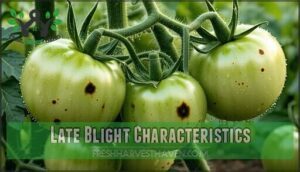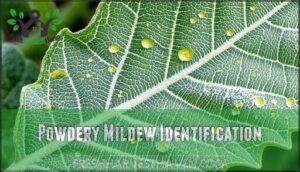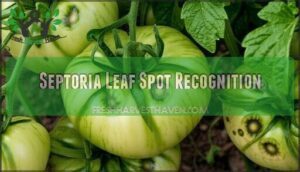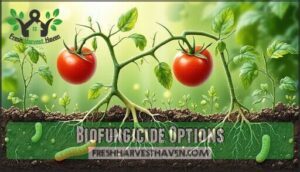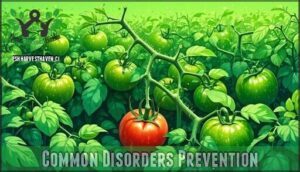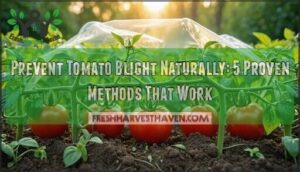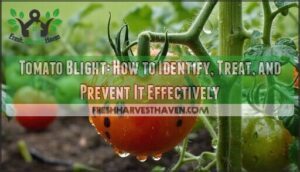This site is supported by our readers. We may earn a commission, at no cost to you, if you purchase through links.
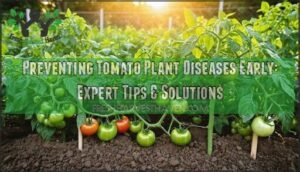
Start with disease-resistant varieties and clean gardening tools between plants. Water at soil level rather than overhead to keep leaves dry, and mulch around plants to prevent soil splashing onto foliage.
Space plants properly for airflow and remove bottom leaves that touch the ground. Practice crop rotation yearly, moving tomatoes to different garden spots.
These simple steps create an environment where diseases struggle to take hold, setting your plants up for success from day one, and following these guidelines will help you achieve a healthy and thriving tomato plant through proper air circulation.
Table Of Contents
- Key Takeaways
- Preventing Tomato Diseases
- Identifying Tomato Diseases
- Managing Fungal Diseases
- Promoting Healthy Plants
- Common Disorders Prevention
- Frequently Asked Questions (FAQs)
- How do I stop my tomato plants from getting early blight?
- How to prevent disease on tomato plants?
- Why should you sprinkle baking soda around your tomato plants?
- What is the best fungicide for early blight on tomatoes?
- Why put baking soda around tomato plants?
- How to keep tomato plants from getting disease?
- Why put Epsom salt on tomato plants?
- What causes curly leaves in tomato plants?
- How can I improve tomato fruit flavor?
- What are the impacts of planting depth?
- Conclusion
Key Takeaways
- Choose the right location and varieties – Select a sunny spot with good drainage and air circulation, then plant disease-resistant varieties to create your first line of defense against common tomato diseases.
- Practice proper watering and spacing – Water at soil level instead of overhead to keep leaves dry, space plants adequately for airflow, and mulch around plants to prevent soil splashing onto foliage.
- Maintain garden hygiene – Remove bottom leaves that touch the ground, clean your tools between plants, and practice crop rotation by moving tomatoes to different garden spots each year.
- Monitor and act early – Watch for disease symptoms like dark spots with concentric rings (early blight) or white powdery coating (powdery mildew), then apply treatments like copper-based fungicides or homemade baking soda sprays immediately.
Preventing Tomato Diseases
You can prevent most tomato diseases by starting with smart choices before planting.
Smart prevention beats expensive cures every time.
Select disease-resistant varieties, choose a sunny location with good drainage, and use clean growing materials to give your plants the best foundation for healthy growth, which includes using disease-resistant varieties.
Choosing The Right Location
When choosing your garden spot, think location, location, location—it’s the foundation of disease prevention.
Proper sunlight exposure, air circulation, and soil drainage create conditions that naturally discourage pathogens from taking hold.
- Sunlight requirements: Select areas with 6-8 hours of direct sunlight daily
- Air circulation: Choose open spaces with natural wind protection from structures
- Soil drainage: Test that water doesn’t pool after rain or watering
- Space allocation: Make certain to have adequate room for proper plant spacing and growth
For ideal results, consider adding organic compost to the soil.
Selecting Resistant Varieties
Resistant varieties serve as your garden’s first line of defense against devastating tomato diseases.
You’ll find disease-resistant cultivars engineered with hybrid vigor and genetic diversity to withstand common pathogens that plague standard varieties.
| Disease Type | Resistant Varieties | Key Benefits |
|---|---|---|
| Early/Late Blight | Mountain Fresh Plus, Iron Lady | Enhanced regional adaptability |
| Bacterial Diseases | Phoenix, Celebrity | Heirloom resistance traits |
| Viral Infections | Better Boy, Big Beef | Grafting options available |
| Multiple Pathogens | Cherokee Purple, Brandywine | Broad-spectrum protection |
These tomato plant varieties combine natural resistance with proven performance, giving you reliable harvests without constant chemical interventions.
Consider exploring options for tomato blight resistance to further protect your crop.
Safe Growing Materials
Before planting your tomato seedlings, you’ll want to gather materials that won’t harbor harmful pathogens.
Start with these essentials for tomato disease prevention:
- Sterile soil or pasteurized potting mix free from disease-causing organisms
- Disease-free seeds from reputable suppliers with proper certification
- Clean tools sanitized with rubbing alcohol between uses
- Safe compost that’s been properly heated to eliminate pathogens
Using organic mulch and maintaining proper sanitation creates the foundation for healthy tomato plant growth.
Identifying Tomato Diseases
You’ll need to catch tomato diseases before they spread throughout your garden and destroy your harvest.
Recognizing the early warning signs helps you act quickly with the right treatment to save your plants.
Early Blight Symptoms
Dark concentric rings on yellowing leaves signal early blight’s arrival in your tomato garden.
You’ll spot these telltale early blight symptoms starting on lower, older foliage first.
The Leaf Spot Appearance begins small but expands rapidly during humid conditions.
| Symptom Stage | Visual Description |
|---|---|
| Initial | Small dark spots on lower leaves |
| Progressive | Concentric Ring Formation creates target-like patterns |
| Advanced | Yellowing Tissue Progression spreads upward through plant |
Early Detection Methods help prevent Defoliation Impact that weakens plants.
Monitor your tomato plant symptoms weekly for effective tomato disease prevention and early disease control against common tomato plant diseases.
Late Blight Characteristics
Late blight’s devastating power makes proper identification essential for your tomato garden’s survival. This mold disease creates greasy brown blotches with distinctive white mold underneath leaves, spreading rapidly in cool, wet conditions.
Late blight can destroy your entire tomato crop in just days if left unchecked.
- Greasy brown lesions appear on leaves and stems
- White fuzzy mold grows on leaf undersides
- Dark spots develop on green fruit surfaces
- Entire plants can die within days of infection
Apply copper spray immediately when symptoms appear, improve air circulation, and practice crop rotation to prevent future outbreaks. You can also use biological control methods for effective treatment.
Powdery Mildew Identification
Unlike late blight’s greasy appearance, powdery mildew creates distinctive white, powdery lesions on tomato leaves.
You’ll spot yellow spots that develop into chalky, flour-like patches on leaf surfaces. This fungal infection spreads through airborne spores, affecting various tomato cultivars differently.
| Feature | Early Stage | Advanced Stage | Management |
|---|---|---|---|
| Lesion Appearance | Small yellow spots | White powdery coating | Remove affected leaves |
| Spore Morphology | Microscopic oval spores | Visible white powder | Apply sulfur dust |
| Affected Cultivars | Susceptible varieties first | All varieties eventually | Choose resistant types |
| Microscopic Analysis | Single spore chains | Dense spore masses | Laboratory confirmation |
| Differential Diagnosis | vs. nutrient deficiency | vs. other white molds | Professional assessment |
Septoria Leaf Spot Recognition
You’ll spot Septoria leaf spot by looking for small, brown, round spots with dark borders on your tomato leaves.
Initial symptoms appear as tiny dark specks that expand into circular lesions about 1/8 inch across. The spot size remains consistently small, while lesion color stays brown with distinctive gray centers.
Disease progression moves upward from lower leaves, and distinguishing features include the characteristic "target" appearance that separates it from other diseases.
Managing Fungal Diseases
When fungal diseases strike your tomato plants, you’ll need effective treatment strategies to save your crop.
You can choose from chemical fungicides, natural homemade solutions, or biological treatments to control these persistent plant enemies.
Fungicide Application Methods
Two precision spray applications weekly work best for effective tomato fungus control.
Use systemic vs. contact fungicides alternately—copper sprays penetrate plant tissues while contact types create protective barriers.
Consider using a systemic tomato fungicide for thorough protection.
Proper spray equipment guarantees dosage precision and uniform coverage.
Application timing matters most: treat before symptoms appear.
Follow resistance management protocols by rotating different fungicide modes of action. This prevents early blight treatment failures.
Homemade Fungicide Recipes
You can create effective homemade fungicide recipes using kitchen ingredients to protect your tomatoes naturally.
These DIY solutions offer affordable alternatives that work against common fungal diseases.
- Baking Soda Spray – Mix 1 tablespoon baking soda per gallon water with 1/2 teaspoon mild soap for better leaf adherence
- Copper Sulfate Mix – Combine water, copper sulfate, and hydrated lime for traditional Bordeaux mixture fungal protection
- Neem Oil Uses – Apply 0.5-1% concentration with biodegradable soap drops for enhanced plant coverage
- Compost Tea Recipe – Steep quality compost in water overnight for nutrient-rich antifungal spray treatment
- Garlic Spray Efficacy – Crush 1 bulb per liter water, steep overnight for natural sulfur compound protection
Many gardeners purchase pre-mixed solutions for convenience.
Biofungicide Options
Nature’s defense squad includes powerful biofungicides for disease prevention.
Bacillus subtilis and Trichoderma harzianum offer copper alternatives while promoting tomato plant health.
These organic treatments excel at application timing for resistance management against fungal diseases.
You can also explore various biopesticides options for specific tomato diseases.
| Biofungicide Type | Best For |
|---|---|
| Bacillus subtilis | Early blight, gray mold |
| Trichoderma harzianum | Soilborne pathogens, root health |
| Microbial lysates | Late blight, powdery mildew |
Promoting Healthy Plants
Building strong, healthy tomato plants starts with smart prevention strategies that work better than any cure.
You’ll save time and frustration by focusing on proper watering, soil management, crop rotation, and choosing disease-resistant varieties from the start.
Proper Watering Techniques
Beyond applying effective fungicide treatments, your watering approach determines whether diseases take hold or stay away.
Smart irrigation techniques create an environment where beneficial organisms thrive while harmful pathogens struggle to establish themselves.
Here are five watering strategies that protect your tomato plants:
- Water at soil level – Direct water to the base using drip irrigation or soaker hoses to prevent leaf splash and reduce humidity around foliage
- Follow morning schedules – Water early in the day so plants dry completely before evening, minimizing overnight moisture that encourages fungal growth
- Monitor soil moisture depth – Check 2-3 inches down to confirm consistent hydration without waterlogging that damages root health
- Apply organic mulch barriers – Spread 2-4 inches around plants to retain moisture, regulate temperature, and prevent soil-borne pathogens from splashing up
- Test water quality regularly – Use clean, pH-balanced water free from contaminants that stress plants and make them vulnerable to infections
Soil Temperature Management
Maintaining ideal soil temperature accelerates germination rates and strengthens root health against disease.
You’ll need soil warming techniques like black plastic mulch or row covers to reach 65-80°F. Different mulch types provide varying insulation levels, with organic materials offering steady temperature control.
Proper soil management creates ideal conditions where beneficial microbes thrive, providing natural disease suppression through improved soil health.
Adding organic matter is essential for maintaining soil fertility to ensure soil fertility and support natural disease suppression.
Crop Rotation Benefits
Crop rotation disrupts disease cycles by preventing soilborne pathogens from establishing permanent homes in your garden.
You’ll boost soil health and nutrient management while breaking pest control problems that plague repeated plantings.
This simple practice increases yield by rejuvenating depleted nutrients and eliminating disease-causing organisms.
Rotate tomatoes with different plant families every three years for maximum disease prevention and garden hygiene benefits.
Resistant Variety Selection
Smart gardeners know that selecting disease resistant tomatoes is your first line of defense against common plant problems.
These varieties offer built-in protection through genetic diversity and hybrid vigor, reducing your need for chemical treatments.
Here are five key strategies for choosing resistant varieties:
- Look for disease codes – Labels like VFN indicate resistance to Verticillium, Fusarium, and nematodes
- Choose local adaptations – Select varieties bred for your specific climate and soil conditions
- Consider grafting benefits – Grafted plants combine disease-resistant rootstocks with quality fruit varieties
- Practice seed saving – Save seeds from your healthiest disease-resistant plants for future seasons
- Research cultivar ratings – Check university extension guides for proven disease-resistant cultivars in your area
These disease-resistant plants give you peace of mind while producing healthy harvests.
Common Disorders Prevention
Even experienced gardeners face common tomato disorders that can derail a perfect harvest if you don’t catch them early.
You’ll prevent most physiological problems by understanding their root causes and implementing targeted solutions before symptoms appear, which is a key step in ensuring a healthy harvest and can be considered a complete solution.
Blossom End Rot Causes
Blossom end rot appears as dark, sunken spots on your tomato’s bottom.
This disorder stems from calcium deficiency, but it’s not always about lacking calcium in your soil.
Watering inconsistency prevents roots from absorbing available calcium properly.
Soil pH imbalances and nutrient competition from excess nitrogen also block calcium uptake.
Root damage from cultivation further limits absorption, creating this frustrating condition, often due to watering inconsistency.
Leaf Roll Prevention
Leaf roll doesn’t spell disaster for your tomato harvest, but prevention beats treatment every time.
This physiological disorder stems from environmental stress rather than pathogens, making your watering practices and cultural practices vital for tomato plant diseases prevention.
A key step is to improve airflow and spacing to minimize humidity.
- Consistent moisture levels – avoid drought stress followed by heavy watering
- Proper pruning methods – remove excessive foliage to reduce plant stress
- Variety selection – choose heat-tolerant cultivars for your climate zone
- Soil health maintenance – guarantee adequate drainage and organic matter content
Blossom Drop Solutions
When temperature swings hit your tomato plants, you’ll notice flowers dropping like autumn leaves.
Pollination problems arise when temperatures exceed 90°F or drop below 55°F, disrupting pollen viability.
Combat temperature extremes with shade cloth during scorching days and row covers during cool nights.
Maintain humidity control around 65-75% and guarantee proper nutrient balance – excess nitrogen causes leafy growth at flowers’ expense.
Choose heat-tolerant varieties for consistent production.
Magnesium Deficiency Treatment
You’ll spot magnesium deficiency symptoms through yellowing between leaf veins on older leaves.
Apply Epsom salt directly to soil or use foliar sprays for quick absorption.
These tomato plant care tips, including the use of chelated magnesium soil amendments, provide long-term correction and prevent deficiency symptoms that reduce fruit development and overall plant health in your garden.
Frequently Asked Questions (FAQs)
How do I stop my tomato plants from getting early blight?
Shield your garden’s green soldiers from early blight’s dark invasion by watering at soil level, mulching around plants, and pruning lower leaves that touch ground.
Apply copper-based fungicide when you spot those telltale brown rings on leaves, which is a clear sign of early blight.
How to prevent disease on tomato plants?
You’ll prevent tomato diseases by spacing plants properly, watering at soil level, rotating crops yearly, removing debris, choosing resistant varieties, and ensuring good air circulation around plants.
Why should you sprinkle baking soda around your tomato plants?
Baking soda fights fungal diseases, raises soil pH, and creates an alkaline barrier that stops spores from growing. You’ll reduce powdery mildew, early blight, and other common infections naturally.
What is the best fungicide for early blight on tomatoes?
Copper-based fungicides work best for early blight on tomatoes.
You’ll want to apply them every 7-14 days when conditions are humid.
Chlorothalonil and mancozeb also provide excellent control against this stubborn disease.
Why put baking soda around tomato plants?
You’ll find gardeners sprinkling baking soda around tomato plants because it raises soil pH and creates an alkaline environment.
That alkaline environment discourages fungal diseases like powdery mildew and early blight from taking hold.
How to keep tomato plants from getting disease?
Think of disease prevention as building a fortress around your tomato kingdom.
You’ll want to rotate crops annually, choose resistant varieties, make certain of proper plant spacing for airflow, water at soil level, and remove plant debris regularly.
Why put Epsom salt on tomato plants?
You’ll apply Epsom salt to tomato plants because it provides magnesium, which helps with chlorophyll production and nutrient absorption.
This prevents yellowing leaves and promotes healthier fruit development throughout the growing season.
What causes curly leaves in tomato plants?
Why won’t your tomato leaves lie flat?
Curly leaves stem from viral infections like yellow leaf curl, environmental stress, herbicide damage, or overwatering.
You’ll also see curling from heat stress, nutrient imbalances, or pest infestations affecting plant health.
How can I improve tomato fruit flavor?
Choose varieties bred for flavor over shelf life, harvest when fully ripe with deep color.
Maintain consistent soil moisture, use organic compost.
Plant in full sun for ideal sugar development.
What are the impacts of planting depth?
Like laying a foundation for a house, proper planting depth sets your tomatoes up for success.
Plant too shallow and you’ll get weak, unstable plants that topple easily.
Plant too deep and you’ll encourage stronger root development and disease resistance through better soil contact.
Conclusion
Remember, an ounce of prevention is worth a pound of cure.
By preventing tomato plant diseases early through proper site selection, resistant varieties, and good cultural practices, you’ll save yourself countless headaches later.
Keep those leaves dry, maintain proper spacing, and rotate your crops annually.
Your vigilant efforts in disease prevention will reward you with robust plants and bountiful harvests.
Start these practices from day one, and you’ll enjoy healthy tomatoes all season long.
- https://ag.umass.edu/vegetable/fact-sheets/solanaceous-early-blight
- https://www.allaboutgardening.com/trellis-tomatoes/
- http://www.tomatodirt.com/pruning-tomato.html
- https://www.vegetables.cornell.edu/pest-management/disease-factsheets/biopesticides/biopesticides-for-managing-diseases-of-tomatoes-organically/
- https://pubmed.ncbi.nlm.nih.gov/34072940/


